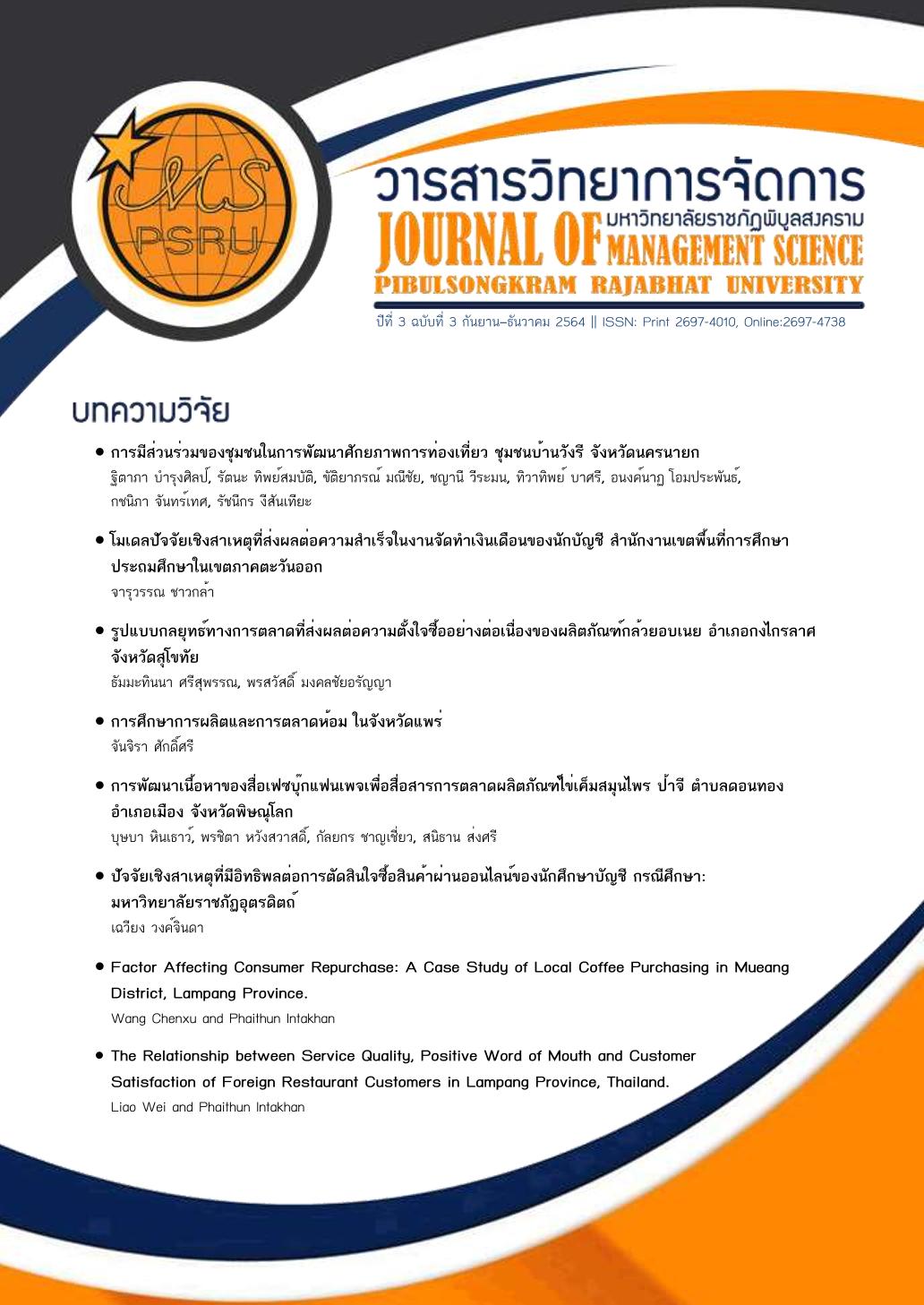Factor Affecting Consumer Repurchase: A Case Study of Local Coffee Purchasing in Mueang District, Lampang Province
คำสำคัญ:
Customer repurchases, Word of mouth, Consumer satisfaction, Personnel, Productบทคัดย่อ
This research is intended 1) to study the level of the opinion of causal factors that influence the customer repurchasing local coffee of consumers in Mueang District, Lampang Province, consisting of product communication, word of mouth, Personnel or staff in the coffee shop and satisfaction 2) to test the influence of factors, causal products, word-of-mouth communication, personnel, and satisfaction towards customer repurchases of local coffee in Mueang District, Lampang Province. This research used an easy sampling from consumers who repeat 408 local coffee. The statistics used in the research were percentage, mean, standard deviation, and regression analysis. The results of the research showed that, the priority of product factors (Product) was at a high level ( = 4.02, SD = 0.491). Personnel factors (People) were at a high level (
= 4.04, SD = 0.509). Customers Satisfied was at a high level (
= 4.02, S.D. = 0.503). Communication factors (Word of Mouth) were at a high level (
= 4.02, S.D. = 0.496) and repurchase factors was at a high level (
= 4.04, S.D. = 0.538). Cause factors for product staff and satisfaction had a positive influence on the purchase of duplicate local coffee of consumers in Mueang District, Lampang Province. Therefore, local coffee shop entrepreneurs should focus on such factors in order to allow consumers to use the service continue to create growth for the business.
เอกสารอ้างอิง
Adam Hayes. (2021). Word-of-Mouth Marketing (WOM Marketing). Retrieved 20 April, 2021, from https://www.investopedia.com/terms/w/word-of-mouth-marketing.asp
Canalejo, A. M. C., & Jimber del Río, J. A. (2018). Quality, satisfaction andloyaltyindices. Journal of Place Management and Development, 11(4), 428-446.
Cronin, J. J., Brady, M. K., & Hult, G. T. M. (2000). Assessing the effects of quality, value, and customer satisfaction on consumer behavioral intentions in service environments. Journal of Retailing, 76(2), 193–218.
Cochran, W.G. (1977) Sampling Techniques. 3rd Edition, John Wiley & Sons, New York.
Department of Business Development. (2021). Business Registration. Retrieved 29 April, 2021, from https://www.dbd.go.th/dbdweb_en/
Devina, M. Astrini, M. R., & Syaebani, M. I. (2016). Employer branding strategies effects on job pursuit intention of business school undergraduates: case study of oil companies in Indonesia. Journal of Entrepreneurship, Business and Economics, 4(2), 1–39.
Frank, B., Enkawa, T., & Schvaneveldt, S. J. (2015). The role of individualism vs. collectivism in the formation of repurchase intent: A cross-industry comparison of the effects of cultural and personal values. Journal of Economic Psychology, 51, 261-278.
Freud, S. (2008). Group psychology and the analysis of the Ego Sigmund Freud. New York: Bantam Books
Fuentes-Blasco, M., Moliner-Velázquez, B., Servera-Francés, D., & Gil-Saura, I. (2017). Role of marketing and technological innovation on store equity, satisfaction and word-of-mouth in retailing. Journal of Product & Brand Management, 26(6), 650-666
Guntitat Horthong. (2020). Lay a business foundation with 7Ps, the basics of marketing that every 'service' business must know!. Retrieved 12 April, 2021, from https://adaddictth.com/knowledge/7Ps-Market.
Hair, J. F., Anderson, R. E., Tatham, R. L., & Black, W. C. (1995). Multivariate Data Analysis Englewood Cliffs: NJ: Prentice-Hall.
Hung, S.-W., Hsieh, S.-C., & Cheng, M.-J. (2015). Consumers’ satisfaction with online group buying – an incentive strategy. International Journal of Retail & Distribution Management, 43(2), 167-182.
Katz, E., Lazarsfeld, P. F., & Roper, E. (1995). Personal influence: The part played by people in the flow of communication. New York: The Free.
Kim, C., Galliers, R. D., Shin, N., Joo-Han, R., & Kim, J. (2012). Factor influencing internet shopping value and customer repurchase intention. Electronic Commerce Research and Application, 11, 374-387.
Komsan Rojanavilaiwut. (2017). Factors influencing the return of using service at Kris Phi Crepe Dessert Shop, Faculty of Commerce and Accountancy. Thammasat University.
Liu, C.-C. (2006). A model for innovation strategies CDFAs in Taiwan. International Research Journal of Finance and Economics, 8, 31-40.
Nattapon Upapanit and Siripong Pruitthiphan. (2012). Customer relationship management and marketing mix affecting the loyalty of fresh coffee consumers at Cafe' Amazon in Bangkok. MMM Review, 8(3), 60-72
Ogba, I.-E., & Izogo, E. E. (2015). Service quality, customer satisfaction and loyalty in automobile repair services sector. International Journal of Quality & Reliability Management, 32(3), 250-269.
Ruefenacht, M. (2018). The role of satisfaction and loyalty for insurers. International Journal of Bank Marketing, 36(6), 1034-1054.
Schiffman, L. G. & Kanuk, L. L. (1987). Consumer behavior. (3rd ed.). New Jersey: Prentice-Hall
Phanthu, S. & Srithong, C. (2019). Factors Affecting Intention to Repurchase Herbal Supplements Online. Journal of Management Science Review, 21(1), 63-72
Subrahmanyam, A. (2017). Relationship between service quality, satisfaction, motivation and loyalty: A multi-dimensional perspective. Quality Assurance in Education, 25(2), 171-188.
The economic times. (2022). Definition of 'Product'. from English Edition Retrieved 3 April, 2021, from https://economictimes.indiatimes.com/definition/product
ดาวน์โหลด
เผยแพร่แล้ว
รูปแบบการอ้างอิง
ฉบับ
ประเภทบทความ
สัญญาอนุญาต
ลิขสิทธิ์ (c) 2021 มหาวิทยาลัยราชภัฎพิบูลสงคราม

อนุญาตภายใต้เงื่อนไข Creative Commons Attribution-NonCommercial-NoDerivatives 4.0 International License.
บทความที่ได้รับการตีพิมพ์ในวารสารวิทยาการจัดการมหาวิทยาลัยราชภัฏพิบูลสงคราม เป็นลิขสิทธิ์ของ คณะวิทยาการจัดการ มหาวิทยาลัยราชภัฎพิบูลสงคราม บทความที่ลงพิมพ์ใน วารสารวิทยาการจัดการมหาวิทยาลัยราชภัฎพิบูลสงคราม ถือว่าเป็นความเห็นส่วนตัวของผู้เขียน คณะบรรณาธิการไม่จำเป็นต้องเห็นด้วย ผู้เขียนต้องรับผิดชอบต่อบทความของตนเอง



